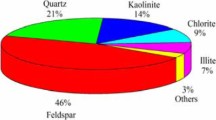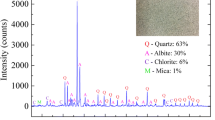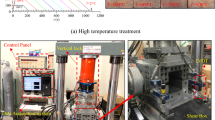Abstract
Long-term experiments were performed on red sandstones after different thermal treatments (25, 300, 700 and 1000 °C) under multi-step loading and unloading cycles and a confining pressure of 25 MPa. Furthermore, to quantitatively analyse the temperature influence on the deformation behaviours of the specimens, the concept of the temperature–strain rate was proposed to describe the relationship between strain and temperature, and the experimental results were corrected to identical temperatures (i.e., 20 °C), to overcome the influence of periodic fluctuations in ambient temperature. The results show that the axial mean temperature–strain rate first increased as temperature increased from 25 to 300 °C and then decreased with increasing temperature, whereas the lateral mean temperature–strain rate decreased with increasing temperature. The total strain was divided into the instantaneous elastic strain, the instantaneous plastic strain, the visco-elastic strain and the visco-plastic strain. The total axial strain increased with increasing deviatoric stress, and the irrecoverable strain increased with increasing loading and unloading history. Furthermore, the total axial strain increased with increasing temperature; specifically, at 1000 °C, it was approximately two times that at 700 °C and three times those at 25 and 300 °C. The instantaneous elastic strain and the instantaneous plastic strain increased approximately linearly with increasing deviatoric stress, whereas the creep strain varied with deviatoric stress in complicated ways at different temperatures. However, under identical deviatoric stress, the instantaneous elastic strain and the instantaneous plastic strain increased slightly as temperature increased from 25 to 700 °C and then increased substantially as temperature reached 1000 °C, whereas the variations in the creep strain, the visco-elastic strain and the visco-plastic strain were dependent on temperature and stress level. Finally, the permeability first decreased slightly as temperature increased from 25 to 300 °C and then increased with increasing temperature.





(modified Yang et al. 2015)

















Similar content being viewed by others
Change history
24 September 2018
In Figs. 14 and 15, the unit (m2) of permeability (k) is mistaken, which should be replaced with (10− 6 m2).
Abbreviations
- AE:
-
Acoustic emission
- A :
-
Sample cross-sectional area
- A, B, m :
-
Fitting parameters
- C 1 :
-
Volume of upstream reservoir
- C 2 :
-
Volume of downstream reservoir
- E me :
-
Instantaneous elastic modulus
- E mp :
-
Instantaneous plastic modulus
- k :
-
Permeability
- L :
-
Sample length
- P 3(t):
-
Upstream gas pressure at time t
- P 4(t):
-
Downstream gas pressure at time t
- \(P_{3}^{0}\) :
-
Initial upstream gas pressure
- \(P_{4}^{0}\) :
-
Initial downstream gas pressure
- P e :
-
Effective porosity
- SEM:
-
Scanning electron microscopy
- t :
-
Time
- V :
-
Sample volume at high temperature
- V 0 :
-
Sample volume at 25 °C
- XRD:
-
X-ray diffraction
- Δk u :
-
Heating temperature–strain rate
- Δk d :
-
Cooling temperature–strain rate
- ΔP t :
-
Differential gas pressure (P3(t) − P4(t)) at time t
- ΔP t + Δt :
-
Differential gas pressure (P3(t) − P4(t)) at time increment Δt
- ΔP 0 :
-
Initial differential gas pressure
- ΔT u :
-
Temperature increment
- ΔT d :
-
Temperature decrement
- Δt u :
-
Heating time
- Δt d :
-
Cooling time
- ε :
-
Total strain
- ε m :
-
Instantaneous strain
- ε c :
-
Creep strain
- ε me :
-
Instantaneous elastic strain
- ε mp :
-
Instantaneous plastic strain
- ε cve :
-
Visco-elastic strain
- ε cvp :
-
Visco-plastic strain
- ε r :
-
Calculated creep strain rate
- µ :
-
Dynamic viscosity
- ρ :
-
Sample density at high temperature
- ρ 0 :
-
Sample density at 25 °C
- σ cd :
-
Crack damage stress
- σ 1, σ 3 :
-
Principal stresses (σ1 ≥ σ3 compression positive)
References
Attewell PB (1973) Fatigue behaviour of rock. Int J Rock Mech Min Sci Geomech Abstr 10(1):1–9
Brace WF, Walsh JB, Frangos WT (1968) Permeability of granite under high pressure. J Geophys Res 73(6):2225–2236
Brantut N, Heap MJ, Meredith PG, Baud P (2013) Time-dependent cracking and brittle creep in crustal rocks: a review. J Struct Geol 52:17–43
Caverzan A, Cadoni E, Prisco MD (2013) Dynamic tensile behaviour of high performance fibre reinforced cementitious composites after high temperature exposure. Mech Mater 59:87–109
Cerfontaine B, Collin F (2017) Cyclic and fatigue behaviour of rock materials: review, interpretation and research perspectives. Rock Mech Rock Eng 51(2):391–414
Chen L, Liu JF, Wang CP, Liu J, Su R, Wang J (2014) Characterization of damage evolution in granite under compressive stress condition and its effect on permeability. Int J Rock Mech Min Sci 71:340–349
Chen L, Wang CP, Liu JF, Li Y, Liu J, Wang J (2017a) Effects of temperature and stress on the time-dependent behavior of Beishan granite. Int J Rock Mech Min Sci 93:16–323
Chen SW, Yang CH, Wang GB (2017b) Evolution of thermal damage and permeability of Beishan granite. Appl Therm Eng 110:1533–1542
Chopra PN (1997) High-temperature transient creep in olivine rocks. Tectonophysics 279:93–111
Danesh NN, Chen ZW, Aminossadati SM, Kizil MS, Pan ZJ, Connell LD (2016) Impact of creep on the evolution of coal permeability and gas drainage performance. J Nat Gas Sci Eng 33:469–482
Dutton SP, Loucks RG (2010) Diagenetic controls on evolution of porosity and permeability in lower Tertiary Wilcox sandstones from shallow to ultradeep (200–6700 m) burial, Gulf of Mexico Basin, U.S.A. Mar Pet Geol 27(1):69–81
Géraud Y (1994) Variations of connected porosity and inferred permeability in a thermally cracked granite. Geophys Res Lett 21(11):979–982
Glover PWJ, Baud P, Darot M, Meredith PG, Boon SA, LeRevelec M, Zoussi S, Reuschle T (1995) Phase transition in quartz monitored using acoustic emissions. Geophys J Int 120:775–782
Hajpál M, Török Á (2004) Mineralogical and colour changes of quartz sandstones by heat. Environ Geol 46(3–4):311–322
Heap MJ, Baud P, Meredith PG (2009a) Influence of temperature on brittle creep in sandstones. Geophys Res Lett 36(19):L19305
Heap MJ, Baud P, Meredith PG, Bell AF, Main IG (2009b) Time-dependent brittle creep in Darley Dale sandstone. J Geophys Res 114(B7):4288–4309
Heap MJ, Baud P, Meredith PG, Vinciguerra S, Bell AF, Main IG (2011) Brittle creep in basalt and its application to time-dependent volcano deformation. Earth Planet Sci Lett 307:71–82
Heard HC, Page L (1982) Elastic moduli, thermal expansion, and inferred permeability of two granites to 350 °C and 55 megapascals. J Geophys Re 87(B11):9340–9348
Heuze FE (1983) High-temperature mechanical, physical and thermal properties of granitic rocks -a review. Int J Rock Mech Min Sci Geomech Abstr 20(1):3–10
Hu DW, Zhou H, Zhang F, Shao JF (2010) Evolution of poroelastic properties and permeability in damaged sandstone. Int J Rock Mech Min Sci 47(6):962–973
Kranz RL (1983) Microcracks in rocks: a review. Tectonophysics 100(1–3):449–480
Lawn B (1993) Fracture of brittle solids. Cambridge Univ Press, Cambridge
Li XZ, Shao ZS (2016) Investigation of macroscopic brittle creep failure caused by microcrack growth under step loading and unloading in rocks. Rock Mech Rock Eng 49:2581–2593
Liu ZB, Shao JF, Liu TG, Xie SY, Conil N (2016) Gas permeability evolution mechanism during creep of a low permeable claystone. Appl Clay Sci 129:47–53
Liu Y, Dai F, Fan P, Xu N, Dong L (2017) Experimental investigation of the influence of joint geometric configurations on the mechanical properties of intermittent jointed rock models under cyclic uniaxial compression. Rock Mech Rock Eng 50(6):1453–1471
Malan DF (1999) Time-dependent behaviour of deep level tabular excavations. Rock Mech Rock Eng 32(2):123–155
Maranini E, Brignoli M (1999) Creep behaviour of a weak rock: experimental characterization. Int J Rock Mech Min Sci 36(1):127–138
Minchener AJ (2005) Coal gasification for advanced power generation. Fuel 84:2222–2235
Mishra B, Verma P (2015) Uniaxial and triaxial single and multistage creep tests on coal-measure shale rocks. Int J Coal Geol 137:55–65
Miura K, Okui Y, Horii H (2003) Micromechanics-based prediction of creep failure of hard rock for long-term safety of high-level radioactive waste disposal system. Mech Mater 3:587–601
MTS Systems Corporation (1999) Model 815 rock and concrete mechanics test system technical description (Version 5)[R]. MTS Systems Corporation, Minnesota
Niu S, Zhao Y, Hu Y (2014) Experimental investigation of the temperature and pore pressure effect on permeability of lignite under the in situ condition. Transp Porous Media 101(1):137–148
Park JW, Rutqvist J, Ryu DW (2016) Coupled thermal-hydrological-mechanical behavior of rock mass surrounding a high-temperature thermal energy storage cavern at shallow depth. Int J Rock Mech Min 83:149–161
Ranjith PG, Daniel RV, Bai JCM, Samintha AP (2012) Transformation plasticity and the effect of temperature on the mechanical behavior of Hawkesbury sandstone at atmospheric pressure. Eng Geol 151:120–127
Rutqvist J, Freifeld B, Min KB, Elsworth D, Tsang Y (2008) Analysis of thermally induced changes in fractured rock permeability during 8 years of heating and cooling at the yucca mountain drift scale test. Int J Rock Mech Min Sci 45(8):1373–1389
Scott TE, Nielsen KC (1991) The effects of porosity on the brittle–ductile transition in sandstones. J Geophys Res 96(B1):405–414
Shalabi FI (2005) Analysis of time-dependent behavior of tunneling in squeezing ground using two different creep models. Tunn Undergr Sp Technol 3:271–279
Shao SS, Ranjith PG, Wasantha PLP, Chen BK (2015) Experimental and numerical studies on the mechanical behavior of Australian Strathbogie granite at high temperatures: an application to geothermal energy. Geothermics 54:96–108
Shoko E, Mclellan B, Dicks AL, Costa JCDD. (2006) Hydrogen from coal: production and utilisation technologies. Int J Coal Geol 65(3–4):213–222
Sirdesai NN, Singh TN, Ranjith PG, Singh S (2017) Effect of varied durations of thermal treatment on the tensile strength of red sandstone. Rock Mech Rock Eng 50(1):1–9
Somerton WH (1992) Thermal Properties and Temperature-related Behavior of Rock/Fluid Systems. Elsevier, Amsterdam, pp 22–29
Souley M, Homand F, Pepa S, Hoxha D (2001) Damage-induced permeability changes in granite: a case example at the URL in Canada. Int J Rock Mech Min Sci 38:297–310
Sterpi D, Gioda G (2009) Visco-plastic behaviour around advancing tunnels in squeezing rock. Rock Mech Rock Eng 42(2):319–339
Stiegel GJ, Ramezan M (2006) Hydrogen from coal gasification: an economical pathway to a sustainable energy future. Int J Coal Geol 65(3):173–190
Sun Q, Lü C, Cao LW, Li WC, Geng JS, Zhang WQ (2016) Thermal properties of sandstone after treatment at high temperature. Int J Rock Mech Min 85:60–66
Sun B, Zhu Z, Shi C, Luo Z (2017) Dynamic mechanical behavior and fatigue damage evolution of sandstone under cyclic loading. Int J Rock Mech Min Sci 94:82–89
Tan X, Konietzky H, Frühwirt T (2014) Laboratory observation and numerical simulation of permeability evolution during progressive failure of brittle rocks. Int J Rock Mech Min 68:167–176
Tian H, Kempka T, Xu NX, Ziegler M (2012) Physical properties of sandstones after high temperature treatment. Rock Mech Rock Eng 45(6):1113–1117
Trippetta F, Colletini C, Barchi MR, Lupattelli A, Mirabella F (2013) A multidisciplinary study of a natural example of a CO2 geological reservoir in central Italy. Int J Green Gas Cont 12(1):72–83
Tsai LS, Hsieh YM, Weng MC, Huang TH (2008) Time-dependent deformation behaviors of weak sandstones. Int J Rock Mech Min Sci 45(2):144–154
Xiao JQ, Ding DX, Xu G, Jiang FL (2009) Inverted s-shaped model for nonlinear fatigue damage of rock. Int J Rock Mech Min Sci 46(3):643–648
Xu XL, Kang ZX, Ji M, Ge WX, Chen J (2009) Research of microcosmic mechanism of brittle-plastic transition for granite under high temperature. Procedia Earth Planet Sci 1(1):432–437
Yamashita S, Sugimoto F, Imai T, Namsrai D, Yamauchi M, Kamoshida N (1999) The relationship between the failure process of the creep or fatigue test and of the conventional compression test on rock. In: 9th ISRM congress, international society for rock mechanics and rock engineering, August, 25–28, Paris, France
Yang SQ, Jing HW, Huang YH, Ranjith PG, Jiao YY (2014) Fracture mechanical behavior of red sandstone containing a single fissure and two parallel fissures after exposure to different high temperature treatments. J Struct Geol 69(Part A):245–264
Yang SQ, Xu P, Ranjith PG, Chen GF (2015) Evaluation of creep mechanical behavior of deep-buried marble under triaxial cyclic loading. Arab J Geosci 8:6567–6582
Yang SQ, Tian WL, Ranjith PG (2017a) Experimental investigation on deformation failure characteristics of crystalline marble under triaxial cyclic loading. Rock Mech Rock Eng 50(11):2871–2889
Yang SQ, Xu P, Li YB, Huang YH (2017b) Experimental investigation on triaxial mechanical and permeability behavior of sandstone after exposure to different high temperature treatments. Geothermics 69:93–109
Ye GL, Nishimura T, Zhang F (2015) Experimental study on shear and creep behaviour of green tuff at high temperatures. Int J Rock Mech Min Sci 79:19–28
Zhang ZX, Yu J, Kou SQ, Lindqvist PA (2001) Effects of high temperature on dynamic rock fracture. Int J Rock Mech Min Sci 38:211–225
Zhao YL, Zhang LY, Wang WJ, Wan W, Li SQ, Ma WH, Wang YX (2017a) Creep behavior of intact and cracked limestone under multi-level loading and unloading cycles. Rock Mech Rock Eng 50:1409–1424
Zhao YL, Wang YX, Wang WJ, Wan W, Tang JZ (2017b) Modeling of non-linear rheological behavior of hard rock using triaxial rheological experiment. Int J Rock Mech Min Sci 93:66–75
Acknowledgements
This research was supported by the Fundamental Research Funds for the Central Universities (2015XKZD05). The authors would like to express their sincere gratitude to the editor and the anonymous reviewers for their valuable comments, which have greatly improved this paper.
Author information
Authors and Affiliations
Corresponding author
Additional information
Publisher’s Note
Springer Nature remains neutral with regard to jurisdictional claims in published maps and institutional affiliations.
Rights and permissions
About this article
Cite this article
Yang, SQ., Hu, B. Creep and Long-Term Permeability of a Red Sandstone Subjected to Cyclic Loading After Thermal Treatments. Rock Mech Rock Eng 51, 2981–3004 (2018). https://doi.org/10.1007/s00603-018-1528-8
Received:
Accepted:
Published:
Issue Date:
DOI: https://doi.org/10.1007/s00603-018-1528-8




